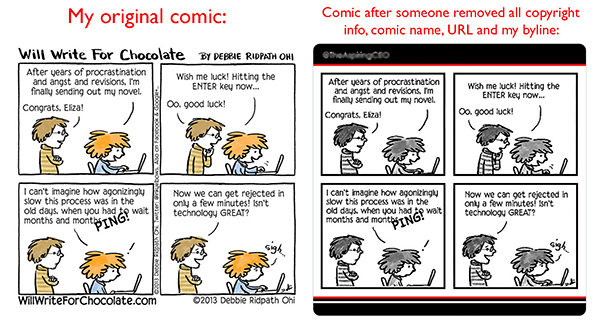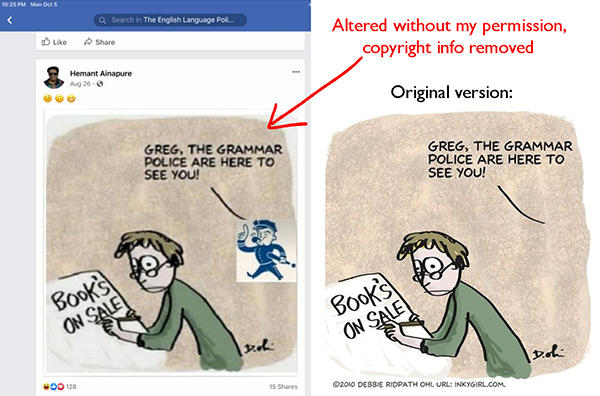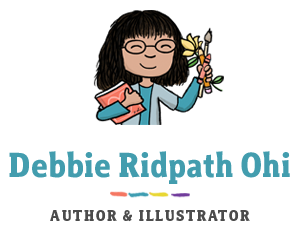
I recently got tagged on a post by someone sharing one of my writing-related comics on Twitter. I usually don’t mind this, but this time I discovered that the person had purposely stripped out all of my copyright info, name of my comic, URL to my comic and my byline, THEN ADDED THEIR OWN BRANDING.
I’m assuming that this was done more from ignorance of copyright laws, else they wouldn’t have tagged me on their post. Their tweet read “Well, isn’t #technology great? Cartoon by @inkyelbows.” It still baffles me how they thought I would be okay with all my copyright info being removed.
Hence this post.
ADVICE FOR THOSE SHARING ART ONLINE:
Sharing someone’s art in a way that makes it look like your own is NOT okay.
Sharing someone’s art after removing their copyright info is NOT okay.
Sharing someone’s art with your own branding is NOT okay.
Using someone’s art for your social media profile user icon is NOT okay unless you have permission. I have been asked many times and I usually politely decline. Main reason: unless my copyright info is clearly visible (and who wants that in their user icon?), there is no way for people to know – they may assume it’s public domain, scoop the image for their own use. In my case, there are some exceptions: back before I started doing children’s books, I did create art for some of my friends to use in their social media profiles, and I’m happy for them to continue using those. 🙂
Modifying someone’s art without their permission is NOT okay. Example of this:

WHAT IF I GIVE CREDIT TO THE ARTIST IN MY SOCIAL MEDIA POST?
I always appreciate a tag/mention when someone shares my art but if the image being shared does not include my copyright info (even if you don’t alter the image), always check with me first. Reason: the image may be scooped and shared elsewhere without your original text.
When I share someone else’s art in social media, I will either just do a straight RT on Twitter, or I will manually add the copyright info myself before sharing if it’s not there already. For the latter, I only do this if I am 100% sure that the illustrator won’t mind (usually they are a friend, or I’m using a sample illustration from their book in one of my blog posts).
ADVICE FOR ILLUSTRATORS SHARING ART ONLINE:
Before posting your image online, always find a way to include identifying info. Whenever possible, I always embed copyright info. This is easier when I’m at home using my desktop computer. When I’m on the road or just have my iPhone, I use iWatermark+ (I would link to the app, but it doesn’t seem to be in the App Store anymore…?)…there are now many watermark apps available. Some free versions allow you a trial period or limited functionality but you need to upgrade to a paid version for full use, so do investigate before committing.
When sharing images online, only upload low resolution images (72 dpi) and small in size. For the latter, however, be aware that if you post an image that is TOO small, it will make it more of a challenge for people to see it properly. I have found the latter a challenge when wanting to share a cover image to help promote a book.
When sharing your art online, ASSUME that your art may be scooped and shared out of context. Often this will be by people who want to help spread the word about you and your art. One of your images may go viral — if there is no identifying info, there is no easy way for people to find out about you and your work. This has happened to me a couple of times early on, which is why I now always try to include identifying info in my images. Even when I’m photographing a casual found object doodle during meal prep, I will always sign my art, and try to remember to include a handwritten “DebbieOhi.com” even if I plan to toss out my radish bird afterward. Because you never know.
WOULDN’T IT BE SAFE TO *NOT* SHARE MY ART ONLINE?
This is a decision that you need to make for yourself.
Despite having my art appropriated inappropriately over the years (including having my art used on a t-shirt that was for sale), I have found the benefits well worth it.
In fact, I have found it useful to have my social media followers and kidlit community friends familiar with my work — several times I have been alerted to copyright infringement because one of them spotted my work elsewhere without appropriate credit, and asked me if I knew about it.
RELATED RESOURCES:
How To Protect Your Art On Instagram With 7 Simple Tips – by Madelaine Buttini
8 Ways To Protect Your Artwork Images From Being Copied Online – by Carrie Lewis on EmptyEasel.com
How To Protect Your Artwork Online – from ArtworkArchive.com
What You Should Know Before Posting Your Art On Social Media – by Samuel P. Kovach-Orr

